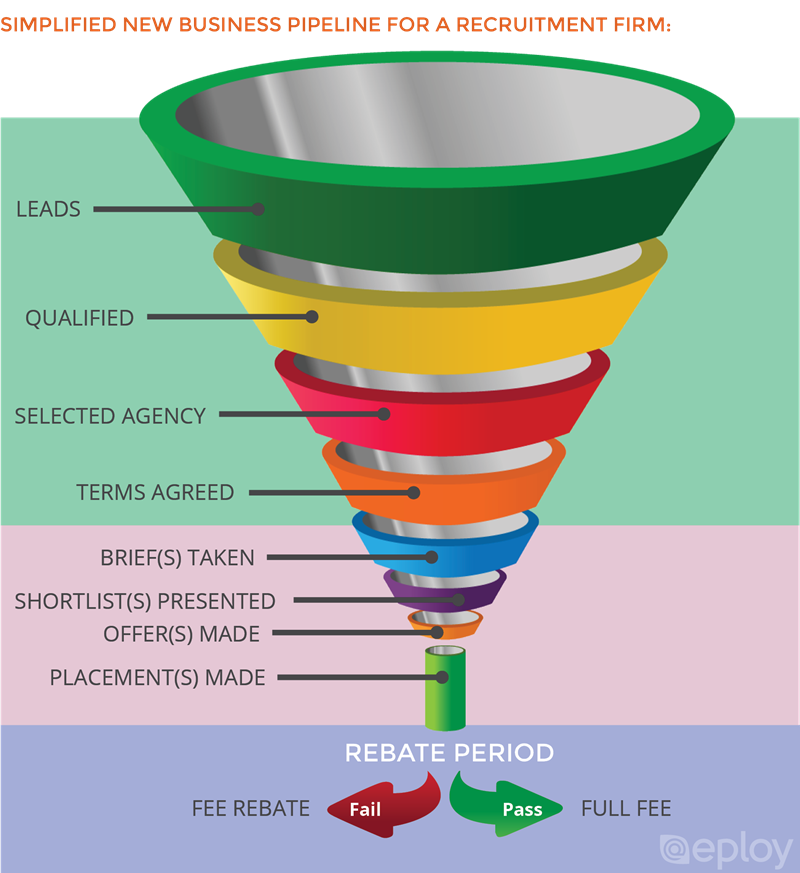Most businesses manage a sales pipeline. You put leads in the top, stuff happens, hey presto...revenues flow. But is this really achievable in the modern recruitment firm? After all, unlike selling widgets, where the widget salesperson is in full control of product supply, recruitment has additional dynamics - since all sides of the ‘trade’ (candidate, client and consultant) require synchronisation. Widgets, on the other hand, rarely have second thoughts about being sold... nor do they suddenly decide to be sold by a different company.
This variability adds uncertainty, making revenue forecasting more complex. But there are many reasons why employing Pipeline Management into your recruitment firm can propel you towards greater billings visibility and profit...
Pipeline management = growth ?
In a 2015 survey published in Harvard Business Review companies with ineffective Pipeline Management reported an average growth rate of 4.6%, conversely companies that implemented three specific pipeline practices saw 28% higher revenue growth. The three specific practices being:
- A clearly defined sales process
- Spending at least three hours per month on pipeline management
- Training sales managers on pipeline management
What does your pipeline look like?
For recruitment firms the pipeline (or sales funnel) consists of:
- Multiple stages that lead to the successful invoicing of a recruitment service.
- Opportunities within each stage of the sales process that require careful and consistent management and assessment.
- A forecast ‘close date’ and probability of closing for each opportunity.
Let's take a look at what a simplified sales pipeline might look like in a modern recruitment firm:

The pipeline is a series of stages that logically align with the client buying and hiring journey. Each stage of the pipeline has been described with a ‘start point’ - leads are qualified, the agency presents its credentials and is selected, terms are agreed, the brief is taken and approved and so on.
Don't forget rebates...
Note also that the output of the funnel - billings, also needs to take into account potential rebates that may be due if the placed candidate fails to complete their induction / onboarding period, this ‘wastage’ needs to be factored in to forecasts.
The pipeline should be an accurate representation of your firm and its sales process. The three bands (Business Development, Workflow and Rebate Period) may have different staff responsible. Or, in smaller or focused teams, a single consultant may manage the entire pipeline cycle - from getting new jobs to filling and following-up.
Define stages with start-points
Of course, your pipeline is likely to look different to the above illustration, with greater (or fewer) stages. But defining the discrete stages for converting leads into sales is the vital first step in implementing Pipeline Management within a recruitment firm. The stages will vary from market to market – the type of recruitment services you are providing and market sector attributes. One thing is clear, sales stages work best when they are defined with ‘start-points’ – thereby providing a definitive distinction between one stage and the next – for example ‘Qualified’ is preferable to ‘Qualifying’. This makes it possible to consistently review sales opportunities and ensure esalesperson and sales manager agree on where exactly each opportunity is currently positioned within the billing journey.
Don't use fingers for forecasting
In many businesses, sales forecasting is often the proverbial ‘wet finger in the air’ – salespeople traditionally apply a ‘percentage chance of winning’ an opportunity based on their ‘gut feel’.
However, salespeople are not homogenous – the ‘happy-go-lucky’ optimist is likely to overestimate their chance of winning each new business opportunity – whereas the more pessimistic pragmatist is likely to under-estimate their chances of success. The result of this becomes increasingly problematic for sales and business management when it comes to revenue forecasting. Even if there is good visibility of current opportunities if the ‘probability of success’ weightings are unreliable then it is likely that the forecasting becomes little more than a coin-toss.
Understanding your Sales Velocity
Effective Pipeline Management can overcome this issue, since it is based on an agreed and repeatable set of chronological stages that are closely aligned to the customer buying journey. Provided data is captured that allows a full audit of each opportunity – the key dates each opportunity passed into each stage – then it becomes possible to calculate the probability of success for opportunities at each stage as well as your sales velocity - the time it takes for opportunities to progress through the stages all the way to close. This helps move forecasting from a ‘guesstimate’ to a data-backed & evidence based process that is far more likely to produce more accurate forecasts.
Implementing Sales Pipeline Management in Recruitment - Whitepaper

If you want to learn more about Pipeline Management, and how it relates to your recruitment firm, download this in-depth whitepaper here